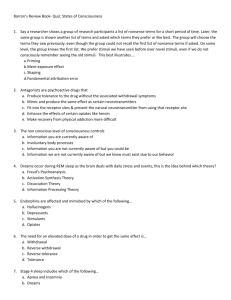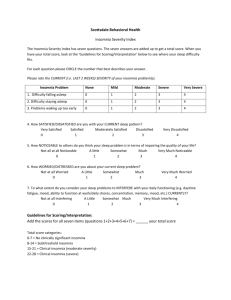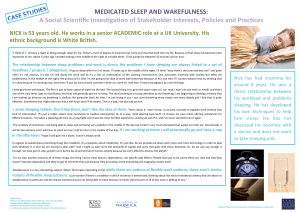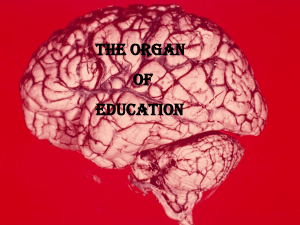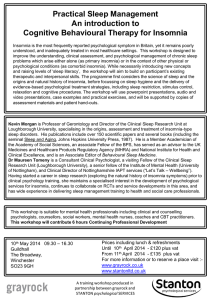Nonpharmacologic Treatments of Chronic Insomnia Reviewed
advertisement
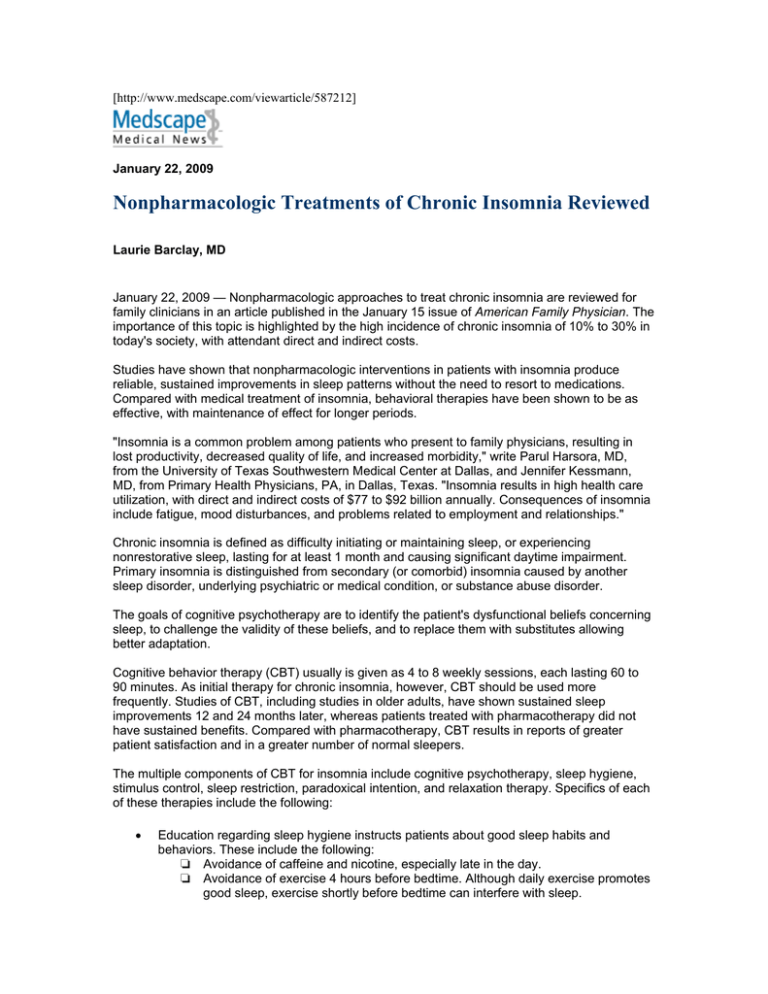
[http://www.medscape.com/viewarticle/587212] January 22, 2009 Nonpharmacologic Treatments of Chronic Insomnia Reviewed Laurie Barclay, MD January 22, 2009 — Nonpharmacologic approaches to treat chronic insomnia are reviewed for family clinicians in an article published in the January 15 issue of American Family Physician. The importance of this topic is highlighted by the high incidence of chronic insomnia of 10% to 30% in today's society, with attendant direct and indirect costs. Studies have shown that nonpharmacologic interventions in patients with insomnia produce reliable, sustained improvements in sleep patterns without the need to resort to medications. Compared with medical treatment of insomnia, behavioral therapies have been shown to be as effective, with maintenance of effect for longer periods. "Insomnia is a common problem among patients who present to family physicians, resulting in lost productivity, decreased quality of life, and increased morbidity," write Parul Harsora, MD, from the University of Texas Southwestern Medical Center at Dallas, and Jennifer Kessmann, MD, from Primary Health Physicians, PA, in Dallas, Texas. "Insomnia results in high health care utilization, with direct and indirect costs of $77 to $92 billion annually. Consequences of insomnia include fatigue, mood disturbances, and problems related to employment and relationships." Chronic insomnia is defined as difficulty initiating or maintaining sleep, or experiencing nonrestorative sleep, lasting for at least 1 month and causing significant daytime impairment. Primary insomnia is distinguished from secondary (or comorbid) insomnia caused by another sleep disorder, underlying psychiatric or medical condition, or substance abuse disorder. The goals of cognitive psychotherapy are to identify the patient's dysfunctional beliefs concerning sleep, to challenge the validity of these beliefs, and to replace them with substitutes allowing better adaptation. Cognitive behavior therapy (CBT) usually is given as 4 to 8 weekly sessions, each lasting 60 to 90 minutes. As initial therapy for chronic insomnia, however, CBT should be used more frequently. Studies of CBT, including studies in older adults, have shown sustained sleep improvements 12 and 24 months later, whereas patients treated with pharmacotherapy did not have sustained benefits. Compared with pharmacotherapy, CBT results in reports of greater patient satisfaction and in a greater number of normal sleepers. The multiple components of CBT for insomnia include cognitive psychotherapy, sleep hygiene, stimulus control, sleep restriction, paradoxical intention, and relaxation therapy. Specifics of each of these therapies include the following: • Education regarding sleep hygiene instructs patients about good sleep habits and behaviors. These include the following: R Avoidance of caffeine and nicotine, especially late in the day. R Avoidance of exercise 4 hours before bedtime. Although daily exercise promotes good sleep, exercise shortly before bedtime can interfere with sleep. R R R R R R • • • • Avoidance of heavy evening meals. Avoidance of naps. Maintaining regular bedtime and awakening hours each day. Keeping the bedroom at a comfortable temperature. Keeping the bedroom as dark as possible. Regularly scheduled relaxation time before bed, with use of relaxation techniques. R Use earplugs if noise is a problem. R Exposure to daytime light for at least 30 minutes in the morning. In stimulus control therapy, patients learn to associate the bedroom with sleep and sex only, rather than with other wakeful activities. To maximize sleep efficiency, sleep restriction therapy limits time spent in bed. By advising the patient to remain awake, the aim of paradoxical intention is to remove the fear of sleep. The goal of educating patients regarding relaxation therapy techniques is to decrease high levels of arousal that interfere with sleep. These techniques include the following: R Autogenic training: imagining a peaceful environment and comforting bodily sensations (warmth and heaviness in the limbs, warmth in the upper abdomen, and coolness on the forehead). R Visual or auditory biofeedback training to allow the patient to control specific physiologic parameters. R Hypnosis. R Imagery training with use of visualization techniques to focus on pleasant or neutral images. R Meditation, abdominal breathing. R Paced respirations: holding a deep breath for 5 seconds, repeating several times, and focusing on the sound of the breath. R Progressive muscle relaxation: tensing and relaxing large muscle groups from the feet all the way up to the facial muscles. R Repetitive focus on a word, sound, prayer, phrase, or muscle activity. Key clinical recommendations for practice, and their accompanying level of evidence rating, are as follows: • • • • For chronic insomnia, CBT should be used as initial therapy (level of evidence, A). Compared with pharmacotherapy, CBT for chronic insomnia is as effective, and the results are more sustainable (level of evidence, B). When immediate symptom relief is desired, medications may be useful for acute insomnia (level of evidence, C). For treatment of chronic insomnia, stimulus control and sleep restriction are effective (level of evidence, B). "CBT is effective for treatment of primary insomnia," the review authors conclude. "However, its use is impeded by several factors, including underdiagnosis of insomnia and lack of awareness among health care professionals. Cost can be a perceived barrier, but because of its sustained effects, nonpharmacologic therapy may be more cost-effective than pharmacotherapy." January 15, 2009, Vol. 79, No. 2, 125-130.
